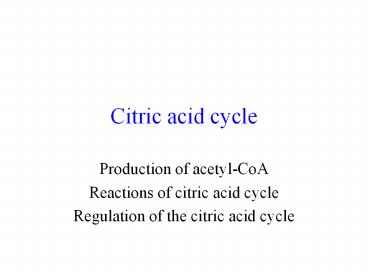Citric acid cycle - PowerPoint PPT Presentation
1 / 32
Title: Citric acid cycle
1
Citric acid cycle
- Production of acetyl-CoA
- Reactions of citric acid cycle
- Regulation of the citric acid cycle
2
Production of acetyl-CoA is catalyzed by a large
enzyme complex
P. 602
Oxidative decarboxylation
3
Pyruvate dehydrogenase complex
P. 570
- Pyruvate dehydrogenase complex includes three
enzymes pyruvate dehydrogenase (E1),
dihydrolipoyl transacetylase (E2), and
dihydrolipoyl dehydrogenase (E3) and also five
coenzymes.
4
NAD
P. 513
5
TPP
p.541
6
FAD and FMN
P. 516
7
Coenzyme A (CoA)
P. 603
8
Lipoic acid (lipoate)
P. 603
- Together with lysine of E2, the lipoyllysyl arm
has enable the E2 becoming more flexible in terms
of catalyzing reactions.
9
Reactions catalyzed by PDH complex
P. 605
10
Decarboxylation of pyruvate by pyruvate
dehydrogenase (E1)
- This step is essentially identical to the
reaction catalyzed by pyruvate decarboxylase and
TPP is also an coenzyme in this step.
11
Transfer and oxidation of the hydroxyethyl group
to E2
- The oxidation of the hydroxyethyl group (yielding
acetyl group) is accompanied by the reduction of
the lipoyl group on E2.
12
Transfer of the acetyl group to coenzyme A,
producing acetyl-CoA
- Although acetyl-CoA is produced, the lipoate
group has became reduced form and has to be
converted to oxidized form again.
13
Oxidation of lipoate by E3
- E3 (dihydrolipoyl dehydrogenase) oxidize the
lipoate group of E2 by withdrawing two electrons
from lipoate, converting E2 back to its original
condition.
14
Electron transfer from FADH2 of E3 to NAD
- The reduced FADH2 of E3 transfers a hydride ion
to NAD, forming NADH. - Now the whole enzyme is ready for another
catalytic cycle.
15
The citric acid cycle
16
1. Formation of citrate
p.608
Oxidative decarboxylation of pyruvate by PDC
17
Citroyl-CoA
p.609
- Citroyl-CoA (citryl CoA) is the high-energy
thioester intermediate happened during
condensation of oxaloacetate and acetyl-CoA. - The hydrolysis of citroyl-CoA pull the reaction
towards citrate synthesis.
18
2. Formation of isocitrate via cis-Aconitate
p.609
Does not dissociate from the active site
Reaction favors this way. However, isocitrate was
quickly consumed in the next step so
19
Aconitase is an enzyme with iron-sulfur center
- The iron-sulfur center of aconitase is in charge
of substrate (citrate) binding and catalysis.
20
3. Oxidation of isocitrate to a-ketoglutarate and
CO2
p610
NAD dependent form mitochondria (citric acid
cycle enzyme) NADP dependent form mitochondria
and cytosol (maintaining NADPH for anabolic
reactions
21
4. Oxidation of ?-ketoglutarate to succinyl-CoA
and CO2
p610
E1 determines substrate specificity E2 very
similar E3 identical
22
5. Conversion of succinyl-CoA to succinate
p575
Nucleoside diphosphate kinase
GTP- or ATP- specific
23
Succinyl-CoA synthetase
p611
Active site
His
a(32kDa)
b(42kDa)
ATP/GTP binding
CoA binding
24
6. Oxidation of succinate to fumarate
p612
Membrane-bound enzyme
25
Malonate is a strong competitive inhibitor of
succinate dehydrogenase
p612
26
7. Hydration of fumarate to malate
p612
27
Fumarase is highly stereospecific
p612
trans
cis
28
8. Oxidation of malate to oxaloacetate
L-
29
p615
3NADH 1FADH2 1GTP/ATP
30
Citric acid cycle components are important
biosynthetic intermediates
p617
31
Anaplerotic reactions of citric acid cycle
32
Regulation of citric acid cycle































